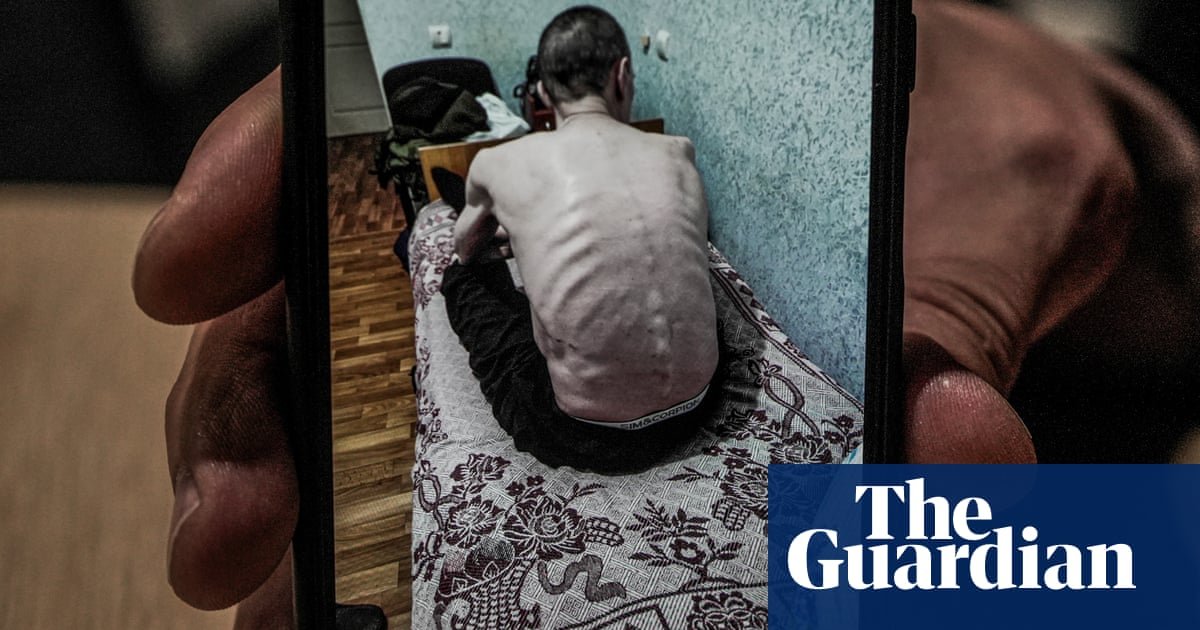The pictures are haunting. There are portraits of Ukrainian men and women who have spent months and years in Russian captivity: soldiers, civilians, paramedics and volunteers. All experienced torture and brutal treatment. Many carry physical scars from their time as inmates. They are among the prisoners of war swapped since 2014, when Vladimir Putin began his Ukraine invasion, with a covert takeover in the east.
In 2019, the Ukrainian photojournalist Zoya Shu began photographing those freed from Russian detention. Over five years, she spent time with former prisoners of war (PoWs) in their homes, talking to them about their life stories and listening to their harrowing accounts of beatings and other forms of daily abuse.
“They suffered. I see them not as victims but as survivors. What they experienced is horrendous,” she says.
Some of those she photographed have terrible wounds. In 2014, Russian “separatist” fighters carved a swastika on the back of a local man, Bogdan Sergiets, in the eastern city of Donetsk. They accused him of supporting Ukraine and being a “Nazi”. Another photo is a portrait of Aiden Aslin, a British volunteer captured in April 2022 while fighting for Ukraine. He and his fellow British prisoner Shaun Pinner, who were both threatened with execution, say they were beaten, stabbed with knives and electrocuted.
Other wounds are less conspicuous. Many prisoners, both men and women, said they were subjected to sexual violence and rape. In Russia and occupied areas of Ukraine, interrogators used a wind-up military field telephone to administer electric shocks, attaching crocodile clips to genitals and nipples.
-
Aiden Aslin, a Briton who was threatened with execution after being captured by Russian forces during the siege of Mariupol in April 2022. The scar on his forehead is from a wound inflicted in captivity
-
From left: Olexander Dyakov, a man from Kherson, displays a scar on his leg caused by Russian guards beating him in the same place over 17 days in captivity; Briton Shaun Pinner shows a knife wound scar
“There is physical and psychological trauma,” says Shu. “It’s difficult to deal with, and profound. It takes a long time to heal.”
Another torture method is starvation. One former prisoner of war, Borys, said he lost 45kg (99lb) during two years in various camps: “I got very thin. When I was released I was so weak I couldn’t put my leg on to a step.”
Borys says a fellow inmate was so emaciated he became unable to walk and “went mad”, adding: “He couldn’t lift his arms. He stopped eating. They took him away. We don’t know what happened [to him].”
-
The basement in Yahidne village, north of Kyiv, where Russians soldiers detained more than 300 civilians for a month. These walls are covered with drawings by some of the 75 children who were held captive
Borys says his captors hit him with plastic pipes and shocked him with stun guns. This was done in a corridor, where there were no CCTV cameras to record the abuse. One day, his guards said his situation would improve if he gave an interview to a Russian propaganda TV channel. They also tried to “re-educate” him.
“They loved to teach us about ‘history’ – we were ‘fascists’. They told us Ukraine was always a part of Russia and didn’t exist,” Borys says.
Other ex-prisoners said they were made to sing the Russian national anthem and recite patriotic poems and songs from Russia. “One goal is to destroy Ukrainian identity,” Shu says, adding that a soldier from western Ukraine who could not speak Russian received extra punishments.
-
Orest, a Ukrainian soldier, was in captivity from August 2022 until April 2023, during which time he says he was regularly beaten for his Ukrainian name
“There is a pattern of constant and systemic violations [of human rights],” Shu says, calling this “state policy”.
Some former detainees have successfully rebuilt their lives. Others remain haunted by their experiences and suffer from depression and panic attacks. According to Kyiv’s Coordination Headquarters for the Treatment of Prisoners of War, 3,405 people have been returned from captivity, including 95 PoWs on 17 July. Tens of thousands of Ukrainians, military and civilians, are believed to remain in Russian jails.
-
Olga developed depression after being held captive for 10 days in Alchevsk, Luhansk region, in August 2014. She was subjected to three mock executions with a machine gun
The exact tally of PoWs is unknown. The figure includes about 1,500 soldiers captured in May 2022 when the garrison defending the Azovstal steelworks in Mariupol surrendered. The Kremlin refuses to give a comprehensive list of the people it holds, adding to the agony of families whose loved ones went missing in action.
Shu is critical of international organisations that help detainees. In her view, they have failed to pressure the Kremlin to improve dire conditions for prisoners and to end widespread abuse.
“Where is the Red Cross? Where is the UN? Where is everybody?” she asks. “There doesn’t seem to be much activity or urgency. The level of brutality and torture in Russian prisons requires immediate action.”
-
Tetiana kisses the urn containing her husband Olexander Aisin’s ashes, 24 August 2019. Aisin died from a heart condition related to the bad conditions he experienced in captivity, a year after his release
